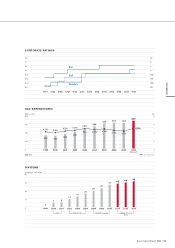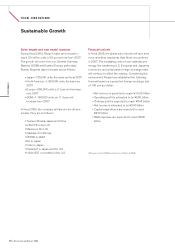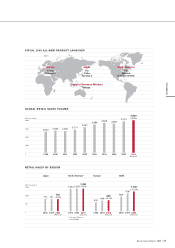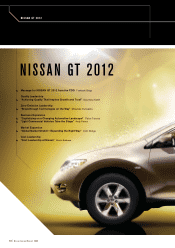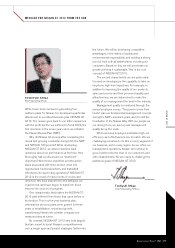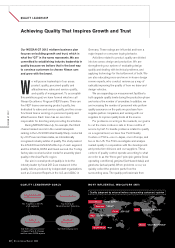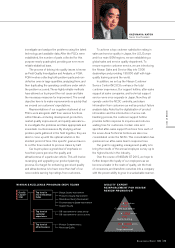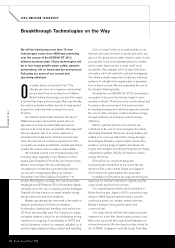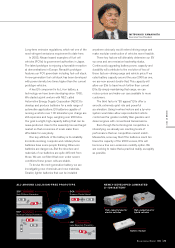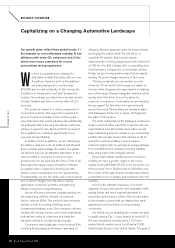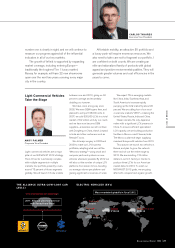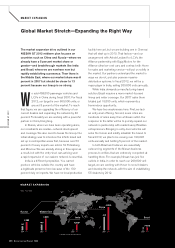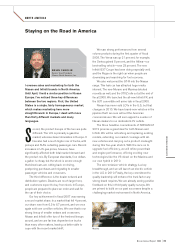Nissan 2008 Annual Report Download - page 27
Download and view the complete annual report
Please find page 27 of the 2008 Nissan annual report below. You can navigate through the pages in the report by either clicking on the pages listed below, or by using the keyword search tool below to find specific information within the annual report.
ALL-AROUND COLLISION-FREE PROTOTYPE NEWLY-DEVELOPED LAMINATED
LI-ION BATTERY
High-capacity type for
electric vehicles High-output type for
hybrid vehicles
Battery module
DCA
Distance Control Assist
Commercialized
LDP
Lane Departure Prevention
Commercialized
SCP
Side Collision Prevention
World’s First
BCP
Back-up Collision Prevention
World’s First
25
Nissan Annual Report 2008
NISSAN GT 2012
MITSUHIKO YAMASHITA
Executive Vice President
Long-term emission regulations, which set one of the
most stringent emissions requirement to date here.
In 2003, Nissan leased examples of fuel cell
vehicles (FCVs) to government authorities in Japan.
The latest prototype is enjoying a favorable reception
at demonstrations in Europe. Renault’s prototype
features our FCV powertrain including fuel-cell stack.
A new-generation fuel cell stack has been developed
with power density two times higher than the current
prototype vehicles.
A key EV component is its Li-ion battery, a
technology we have been developing since 1992.
We started a joint venture with NEC called
Automotive Energy Supply Corporation (AESC) to
develop and produce batteries for a wide range of
automotive applications. EV batteries capable of
running a vehicle over 100 kilometers per charge are
still expensive and huge, weighing over 200 kilos.
Our goal is a light, high-capacity battery that can be
mass-produced close to the assembly line and target
market so that economies of scale make them
affordable for everybody.
One key attribute of the battery is its reliability.
Incidents involving computer and cellular phone
batteries have some people thinking lithium-ion
batteries are dangerous. But the structure and
materials of our batteries are quite different from
those. We are confident that even under severe
conditions these power cells are stable.
To devise the next-generation battery, we are
investigating new chemicals and new materials.
Smaller, lighter batteries that can be installed
anywhere obviously would extend driving range and
make modular construction of vehicles more feasible.
Three key factors will ultimately determine our EV
success and zero-emission leadership status.
Continuously upgrading battery power, capacity and
durability will contribute to the evolution of two of
those factors—driving range and vehicle price. If we
rated battery capacity around the year 2000 as one,
we are now around double that. This capacity will
allow our EVs to travel much further than current
EVs. By simply maintaining that range, we can
reduce prices and make our cars available to more
customers.
The third factor is “EV appeal.” EVs offer a
smooth, extremely quiet ride and powerful
acceleration. Using in-wheel motors and a by-wire
system would also allow unprecedented vehicle
control and far greater mobility than gasoline and
diesel engines with conventional transmissions.
Even though the technological competition is
intensifying, we already are reaching levels of
performance that our competitors cannot match.
Meanwhile, some say that if the batteries reach ten
times the capacity of the 2000 version, EVs will
become a true zero-emissions mobility option. We
are working to make that a practical reality, as rapidly
as possible.


